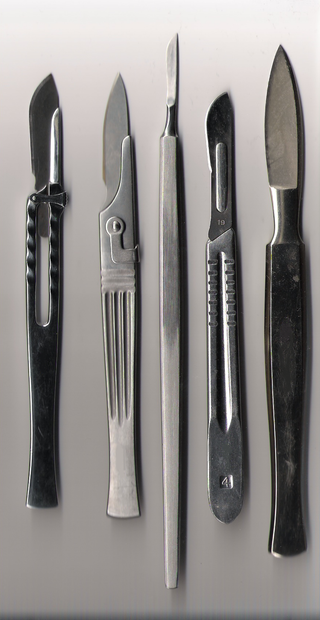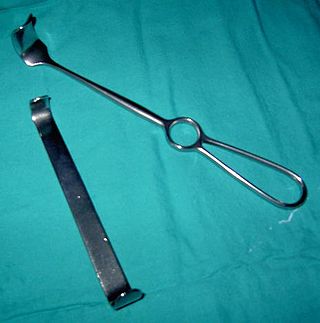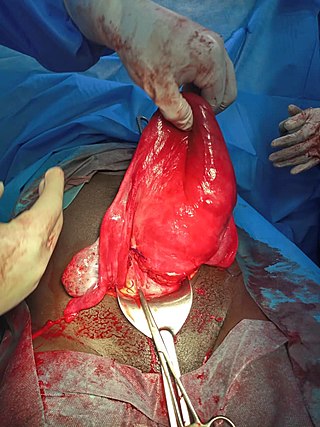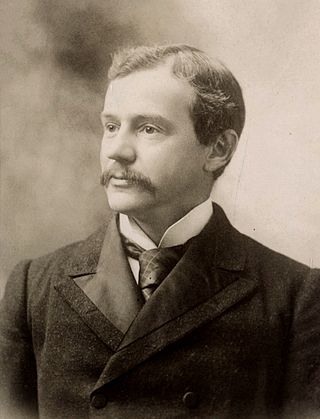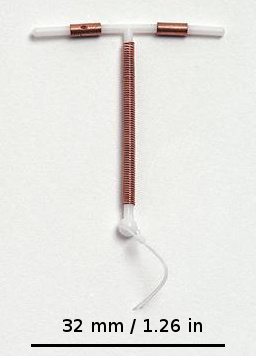The following is a list of instruments that are used in modern obstetrics and gynaecology. [1] [2]
| Instrument | Uses | |
|---|---|---|
| Speculum | A specialized form of vaginal speculum is the weighted speculum, which consists of a broad half tube which is bent at about a 90 degree angle, with the channel of the tube on the exterior side of the angle. One end of the tube has a roughly spherical metal weight surrounding the channel of the speculum. A weighted speculum is placed in the vagina during vaginal surgery with the patient in the lithotomy position. The weight holds the speculum in place and frees the surgeon's hands for other tasks. | |
| Auvard's speculum | Speculum used in standard vaginal procedures. | |
| Cusco's speculum | Bivalved self retaining speculum. Its advantage over Sim's speculum is that no assistance is required to hold it in place. Hence, minor procedures like papsmear, IUCD insertions can be performed independently. Its disadvantage is the limited visualization of vagina walls. | |
| Sim's double-bladed posterior vaginal speculum | ||
| Scalpel | ||
| Vulsellum | ||
| Single toothed vulsellum | ||
| Multiple toothed vulsellum | ||
| Giant vulsellum | ||
| Mucus sucker - disposable or metal | ||
| Forceps | ||
| Long straight hemostatic forceps | ||
| Allis tissue forceps | ||
| Babcock's forceps | ||
| Lanes tissue forceps | ||
| Uterus holding forceps | ||
| Sponge holding forceps | ||
| Kocher's artery forceps | ||
| Kocher's forceps with toothed jaws [3] | ||
| Green-Armytage hemostatic forceps | - Can be used during Myomectomy. | |
| Willet's scalp traction forceps | ||
| Ovum forceps | ||
| Punch biopsy forceps | - Used in Premalignant lesions of the cervix. Its provides a specimen. | |
| Uterine dressing forceps | ||
| FemCerv Endocervical Sampler | The FDA cleared disposable FemCerv endocervical Sampler can be used to biopsy the endocervical canal during colposcopyor the evaluation of abnormal uterine bleeding. FemCerv is intended to collect a 360° Endocervical tissue sample for histological evaluation. After collection the device is closed to contain and protect the sample within the patented collection chamber. To release the tissue sample the device is opened and the tip swished in a vial of fixative. The sample is then sent to the pathology lab for processing.. | |
| SpiraBrush CX | An ectocervical biopsy brush used in place of punch forceps during colposcopy to collect a full transepithelial tissue sample. The resulting sample is then sent to a pathology lab for evaluation and diagnosis of cervical cancer. Abnormalities in these samples are similar to those seen in traditional cervical biopsies, and range from reactive squamous and glandular epithelial cells to overt invasive carcinoma. [4] | |
| SoftECC | The FDA Compliant disposable Soft-ECC endocervical curette can be used to biopsy the endocervical canal during colposcopy or the evaluation of abnormal uterine bleeding. Unlike the conventional sharp endocervical curette, the Soft-ECC is intended to gently frictionally abrade and collect abundant trans-epithelial tissue samples into the patent pending KYLON fabric. The tip device containing the sample can be placed in the fixative vial and transported to the lab. In the lab, the tissue can be easily and efficiently removed from the curette fabric for processing that is identical to the conventional endocervical curettage tissue sample. | |
| SoftBiopsy | The FDA Compliant disposable SoftBiopsy can be used to biopsy the exocervix and lower genital tract during colposcopy or when a suspicious lesion is detected. Unlike the “sharp edge” biopsy design of gynecological biopsy devices, the SoftBiopsy design is intended to gently frictionally abrade and collect abundant trans-epithelial tissue samples into the patent pending KYLON fabric. The tip device containing the sample can be placed in the fixative vial and transported to the lab. In the lab, the tissue can be easily and efficiently removed from the curette fabric for processing that is identical to the conventional lower genital tract biopsy or curettage tissue sample. | |
| Laminaria tent introducing forceps with laminaria tent | ||
| •Needle holding forceps | ||
| ••Straight | ||
| ••Curved | ||
| •Toothed dissecting forceps | ||
| •Untoothed dissecting forceps | ||
| •Delivery forceps | ||
| ••Long curved obstetrics forceps | ||
| ••Das's long curved obstetrics forceps | ||
| •• Wrigley's forceps | ||
| ••Kielland's forceps | ||
| Axis traction device | ||
| Cannula | ||
| •Karman's plastic suction cannula | ||
| •Hysterosalpingography cannula | ||
| •Insufflation cannula | ||
| •Budine's cannula | ||
| Scissors | ||
| •Episiotomy scissors | ||
| •Embryotomy scissors | ||
| •Mayo's scissors | ||
| •Bonney scissors | ||
| •Metzenbaum scissors | ||
| •Perineorrhaphy scissors | ||
| •Long straight scissors | ||
| Uterine sound | ||
| Cervical dilators | ||
| •Hawkin-Ambler's | ||
| •Das | ||
| Ventouse cups | ||
| •Metallic | ||
| •Silastic | ||
| Oldham's perforator | ||
| Cranioclast | ||
| Hook with crochet | ||
| Jardine's decapitation hook with knife | ||
| Pinnard's stethoscope | ||
| Disposable cord-clamp | ||
| Curette | ||
| •Flushing curette | ||
| •Uterine curette | ||
| •Sharp curette | ||
| •Shaman's curette | ||
| Retractors | ||
| •Doyen's retractor | ||
| •Landon's retractor | ||
| •Anterior vaginal wall retractor | ||
| •Balfour self-retaining retractor | ||
| •Deaver's retractor | ||
| Electronic fetal monitor with abdominal transducers | ||
| Implants | ||
| •Copper-T uterine | ||
| •Hormonal implants e.g. Norplant | ||
| Laparoscopic instruments for tubal sterilization | ||
| •Veress needle | ||
| •Trochar | ||
| •Cannula | ||
| •Hysteroscope | ||
| •Telescope | ||
| •Coagulators | ||
| •Graspers | ||
| •Scissors | ||
| Spatula and cytobrush | ||
| Catheters | ||
| •Metallic - male or female | ||
| •Rubber | ||
| Myoma screw | Used to stabilize and manipulate non-degenerating myomas, fibroids or other tissues intended for removal during laparoscopic procedures. | |
| Towel clips | ||
| Clamps | ||
| •Bonney's myomectomy clamp | ||
| •Cervical occlusion clamp | ||
| •Barkelay Bonney vaginal clamp | ||
| Pessary | ||
| •Hodge-Smith type | ||
| •Ring type | ||
| Colposcope | ||
| Perineometer |
- Axis traction device for delivery forceps
- Cusco's self retaining bivalve vaginal speculum seen from behind
- Cusco's self retaining bivalve vaginal speculum (closed) seen from the left. It is very much used in taking smears from the vagina for Papanicolaou test and routine examinations.
- Cusco's self retaining bivalve vaginal speculum (opened) seen from the right
- Cusco's self retaining bivalve vaginal speculum (closed) seen from the right
- Das's modification to the long curved delivery forceps (shorter in length) with axis traction devices in place, seen from the right side (left blade on top: with respect to the mother's vaginal wall)
- Das's modification to the long curved delivery forceps (shorter in length) with axis traction devices in place, seen from the right side (left blade in front: with respect to the mother's vaginal wall). The instrument is held in properly as during a delivery.
- Das's modification to the long curved delivery forceps with the blades lying loose. The one with the lock is the left blade (judged with respect to the mother).
- Das's modification to the long curved delivery forceps with the blades locked in place
- Metallic cup for the Ventouse suction device used to assist deliveries
- Sim's double-bladed vaginal speculum
- Sim's double-bladed vaginal speculum
- Allis tissue forceps
- Allis tissue forceps
- Doyen's retractor
- Kocher's forceps with toothed jaw
- Disposable manual mucous sucker
- Straight needle holding forceps
- Jardine's decapitation hook with knife
- Jardine's decapitation hook with knife
- A cranioclast
- Budine's cannula
- Hook with crochet
- Oldham's perforator
- Ayre's spatula and Slide holding bottle(open) used for Papanicoulau smear
- Ayre's spatula and Slide holding bottle - Koplick's jar (open) used for Papanicoulau smear
- Upper-Long straight hemostatic forceps;Lower-Kocher's hemostatic forceps




































